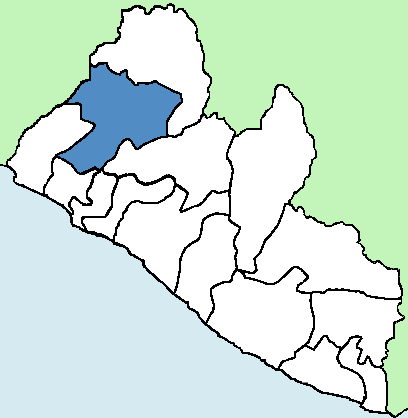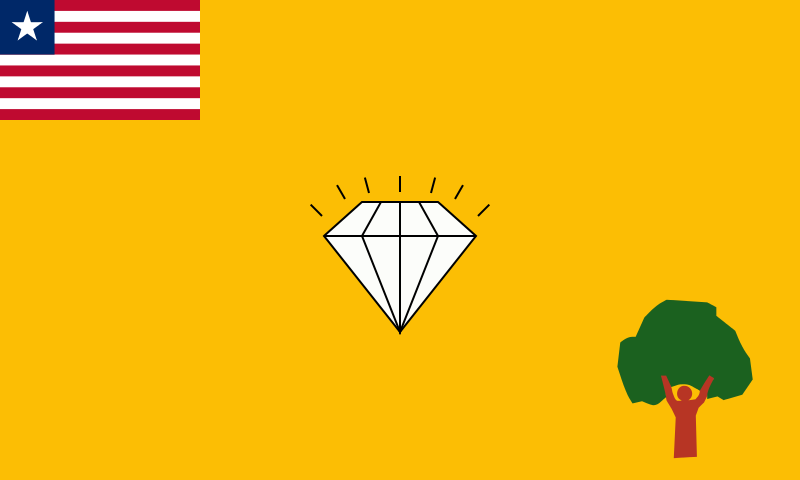Gbarpolu
Pronunciation: gba-po-lu |
|||
| Established | Part of Condo Kingdom -Hinterland -Western Province -Gbarma and Bopolu Districts, Lofa County Jan 2001: Gbarpolu County |
Capital | Bopolu |
| Location | West | Area | 3,904.88 sq mi (10.1%) |
| Population | 83,758 (2.4%) | Population Density | 21/sq mi |
| Tribes | Kpelle 53%, Gola 31%, Gio 6%, Kissi 2%, Other 8% | Religion | Christian, Muslim, Traditionalist |
| Administrative Districts | Belleh, Bokomu, Bopolu, Gbarma, Gounwolalia, Koningba | Electoral Districts | 3 |
Gbarpolu is the newest county of Liberia. It was established in 2003 with the merger of Gbarma and Bopolu districts from the lower portion of Lofa County. It is one of the nation’s largest counties, and it is located in the west along the border with Sierra Leone.
Bopolu City is the capital of Gbarpolu. It is the home and burial place of King Sao Boso, of the Condo Kingdom. This kingdom was a federation of various tribes, and was governed by King Sao Boso (also called Bostswain). Bopolu was known as a major trading post in the interior where the natives barter traded their goods and produce. Some accounts state that it was along the trans-Saharan trade route, however, it seems most trading in the Bopolu region was local.
In 1868 Bopolu’s only market met daily. As described by Anderson, the market was held in the northeast section of town: The bartering is carried on solely by women. There is no established currency; the exchange takes place of one commodity for another, according to their mutual necessities. It is generally attended by one hundred and seventy-five to two hundred persons. The articles are palm oil, rice, kaffee-seed, shallots–a small species of onion–met, cotton stripes [sic], tobacco, kola, earthen pots, etc.
-Handwerker
Gbarpolu consists of six administrative districts and three electoral districts. The 2008 census had its population at 83,388. It was classified as sparsely populated with a density at 21 people per square mile. The main tribes living in Gbarpolu are the Kpelle, Gola and Gio. Neglected and impoverished describe Gbarpolu and its residents, like other interior areas of Liberia.
The county’s flag has a gold background with a diamond in the middle, and a tree in the right corner. These symbols represent the county’s rich resources which include diamond, gold, timber and iron ore. Gbarbolu has also had its share of unregulated gold and diamond mining activities. It has a typical tropical climate with a lengthy rainy season and contains fractions of the Upper Guinea Forest. The Kpo and Fanyea are its main mountain ranges, and its major rivers include the Lofa, St. Paul and Mahe.
Sources
2008 Census Atlas. Liberia Institute of Statistics and Geo-Information Services (LISGIS). Republic of Liberia. Web.
Cahoon, Ben. Liberia. Worldstatesmen. 2000.
Ciment, James. Another America : the Story of Liberia and the Former Slaves Who Ruled It. 1st ed. New York: Hill and Wang, 2013. Print.
Gbarpolu County Development Agenda. Ministry of Internal Affairs. Republic Of Liberia, 2008. Web.
Gbarpolu County Profile. The Liberia Institute for Statistics and Geo-Information Services (LISGIS). Republic of Liberia. Web.
Handwerker, Penn W. Market Places, Travelling Traders, and Shops: Commercial Structural Variation in the Liberian Interior Prior to 1940. African Economic History. University of Wisconsin Press. 1980.
Law, Gwillim. Counties of Liberia. Statoids. Web.
Legislature of Liberia. Web.
Overview of Gbarpolu County. Ministry of Internal Affairs. Republic of Liberia. Web.
Views: 343


August 10, 2022 @
Thanks for this detailed profile of my county.
August 10, 2022 @
Very informative. I learned a lot!
August 10, 2022 @
I love you Gbarpolu!!!!